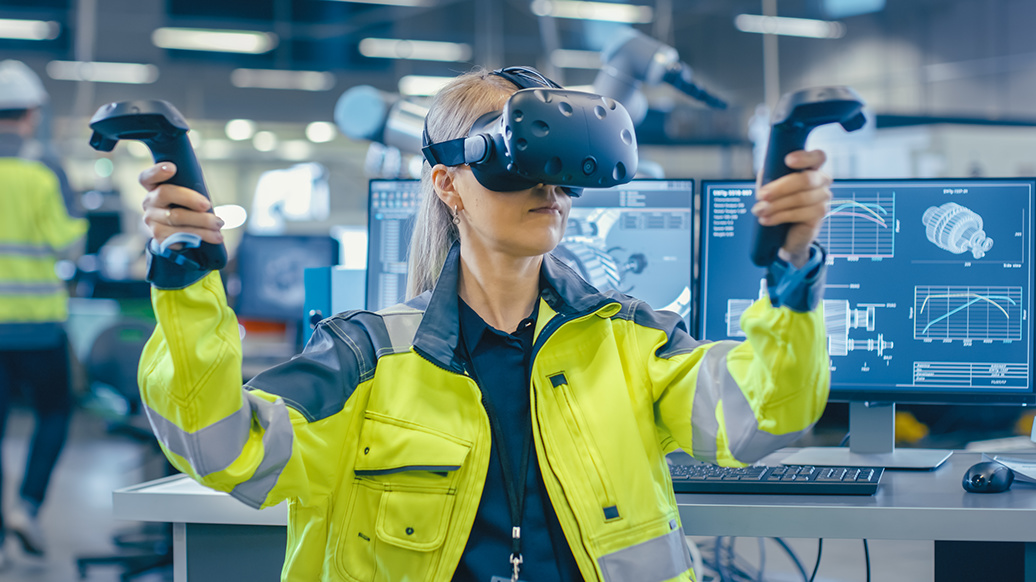XR (Virtual/ Augmented/ Mixed Reality) in Product Creation

Authors: Slim Krückemeier, M.Sc.; Prof. Dr.-Ing. R. Anderl., Johannes Olbort, M.Sc.
The term XR covers everything from mixed reality (MR), the use of holograms for object visualization, to virtual and augmented reality (VR and AR).
Industrial production and the service sector are currently undergoing a complex process of change, both on a national and international level. In the context of globalization and the resulting accelerated dissemination of new technologies, customers are expressing an increased desire for individualized solutions. As a result, the market is becoming more dynamic and product life cycles are becoming shorter. To remain competitive, companies must therefore find innovative solutions to shorten the product development phase.
So, the efficient, time-optimized development of new products is more important than ever. Especially in the context of Industry 4.0, a large amount of digital information accumulates, which must be filtered and processed. The integration of XR technologies into the processes of product development provides a promising approach to the processing of such information. The integration of XR technologies makes it possible to provide the user with digital information in real-time and with pinpoint accuracy, which helps him to perform his tasks more efficiently while at the same time ensuring high quality.
Previous activities focused on developing a process chain from CAD to Mixed Reality using the JT-format and further enabling Multi-Body-Simulations in Mixed Reality. Instead of just working with use cases that come to mind we took a step back for performing a holistic analysis to scientifically elaborate potential use cases for Mixed Reality in the product creation phase. Therefore, an identification, classification, and feasibility study and development of use cases were carried out.
For the classification, three different classes have been used. It is necessary to consider as many users as possible, who differ in their tasks and are therefore clearly identified, and their various activities. For this reason, users and activity were defined as a class. With the third class, the phase in the product creation process, use cases can be identified explicitly. The three classes and their corresponding characteristics are shown in figure 1.

With the User class, the respective users of the human-machine interface of an XR technology are recorded. Therefore, they can use the XR technology to perform a specific technical task. To fulfill these tasks, users need to perform different activities like Negotiating & Determining. Those are represented in the Activities class. Depending on the phase of the product creation process different requirements have to be met, even if the same user is performing the same activity. So, the last class for classification represents the Product Creation Process Phase. For the identification of the use cases, all characteristic combinations of the three classes were examined and checked for their viability. The results are displayed in a Sankey-Diagram, which is shown in figure 2. The width of the arrows shows the ratio of the frequencies with which the possible use cases for the utilization of the XR technology occur in the respective paths.

From the identification of the use cases, it emerged that the XR technology can support especially the users Designer and Manager in the communication with a customer like the external client or the private customer, but also in the development. On the other hand, XR can help a Customer to better clarify his wishes and product requirements and thus support him in negotiations with managers and developers. There are also a large number of use cases in which the work of the Production Staff can be made easier or safer. Furthermore, it can be recognized that XR technology can be used sensibly throughout the entire product development process to make the work of users easier and provide more safety. A similarly distributed picture emerges for the activities. Clarify/Analyze, Negotiate/Determine, and Examine/Test can be facilitated most by using the right XR technology. These are the activities that are mainly performed by developers, managers, and production staff, which shows the connection to the User class.
Subsequently, selected use cases were summarized into use contexts, elaborated in more detail and a feasibility study was conducted. Some of which are factory planning, XR CAD, workman support, and quality management. The choice of use contexts was made with a focus on covering as broad a spectrum of identified use cases as possible so that all characteristics of the systematics are represented. The subsequent feasibility study was carried out as part of a SWOT analysis, in which the strengths and weaknesses of the technology were analyzed in the context of the respective use context, as well as the opportunities and risks that result for the company. This showed that XR technologies offer a great opportunity to support users in their work and thus to increase efficiency in the context of product development. Among other things, rapid fatigue can be prevented and user safety can be increased, e.g. through warning systems. Furthermore, XR technologies can be used to improve communication and cooperation. This is a growing field of application, especially due to the global cooperation of companies. Also, a graphical representation, e.g. of a future product environment through the use of VR, can be very helpful in negotiations in the communication between developer and customer and lead to a better understanding.